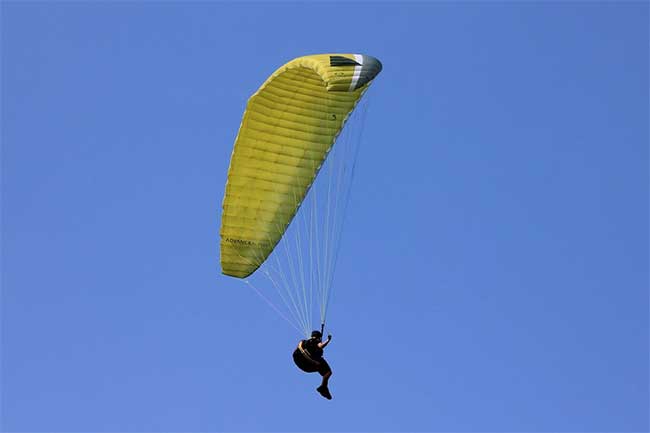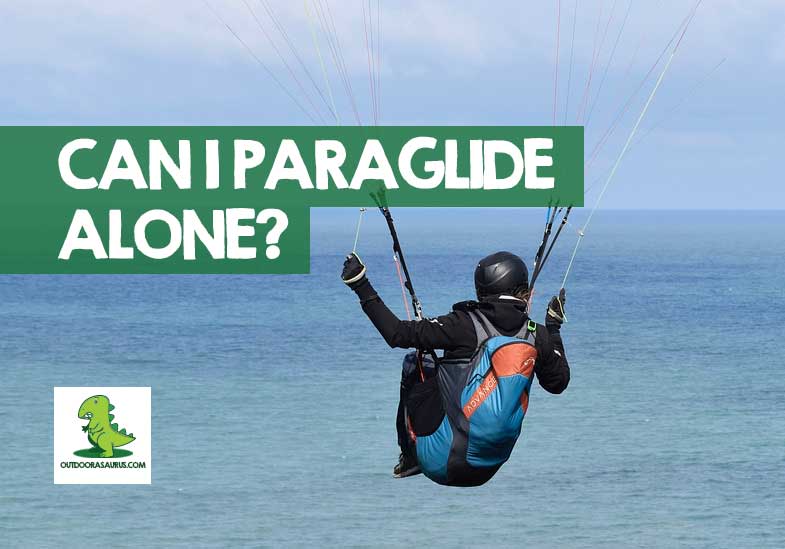Paragliding is one of the most exciting yet potentially dangerous sports ever invented. I had a few paragliding lessons a couple of years back and realized that it was actually quite an easy activity to learn (personal experience only). However, since it involves a lot of flying, it can be risky, and you won’t find any beginners that paraglide alone, least of all without taking any lessons or training first! I decided to carry out some research and write a post about some of the most important aspects of paragliding.
Can I paraglide alone? Yes, you can. Solo paragliding is possible if you have enough training and practice. An elementary pilot course can get you started by teaching you how to take off with assistance and fly alone for a few minutes. With extensive pilot training, you’re able to fly out by yourself without any supervision.
Beginners can start making short flights after one or two days of training. This is, of course, with the help of their trainers. It takes about 7 to 14 days to become savvy enough to make individual flight decisions.
Can I paraglide alone without training or lessons?
Paragliding is an easy activity that involves the simplest form of human flight. Apart from the equipment used, your knowledge and paragliding skills are what will help you stay safe. Knowing what to have, how to read weather patterns, and how to manipulate the laws of physics goes a long way. This makes it necessary to undergo training and take lessons from a certified paragliding school.

Beginners are also advised to familiarize themselves with basic paragliding equipment. The average paragliding gear consists of a wing, a harness, a reserve parachute, headgear, and a paragliding variometer.
Wing
A paragliding wing is also known as a canopy or ram-air airfoil. It forms the largest part of the paragliding equipment. Depending on the design, wings vary in size, dimension, and form. They are built to fit and accommodate an individual depending on their weight, the harness weight, flying clothing, boots, water, radio, knapsack, and other essential items.
Harness
The harness is where the pilot sits or stands as he/she flies. It is attached to the wing via baffled cells. Today, a modern harness also functions as a backpack. It also features foam and airbag protectors below the seat to protect pilots from severe back injuries in case of landing failure.
Reserve parachute
The reserve parachute is the second most important component of the paragliding equipment. It’s deployed in case a pilot makes an irreversible error or experiences a problem with the wing.
Handy Hint: You can read more about how reserve parachutes work in paragliding here.
Headgear
The headgear comprises a safety helmet that protects pilots from head injuries in case of an accident. A typical safety helmet is made of carbon fiber and fiberglass. Most helmets will vary according to pilot requirements.
Some pilots even prefer using hard-shell bike helmets for protection.
Paragliding variometer
A variometer helps pilots to determine how fast they are falling or climbing in relation to the ground. They feature audio indicators that give information without having to look at the instrument. Pilots are able to gain height and locate areas where there is rising air in case they start to sink.
Other paragliding instruments include radios, GPS, hand-wear covers, hook knives, and traveling fits. Their use depends on the regional environment in which a pilot is flying and the prevailing conditions. Before attempting to paraglide, ensure that you’re properly trained.
This allows you to paraglide safely, learn how to use paragliding equipment, and to minimize chances of ever being in an accident.
Is it safe to do paragliding with no lessons?
According to statistics, paragliding is as safe as driving. Only 1 out of 10,000 people die in a car accident every year in the US. If you live in a country where the statistics are worse, paragliding is much safer. The safety of a pilot depends on his attitude, judgment, and flight behavior.
Handy Hint: Ever wondered if paragliding was safer than hang-gliding? I’ve done all the research for you in this post on safety statistics.
The average paraglider is built to achieve the highest levels of stability while flying. Even in the event of equipment failure, paragliders are designed to recover fast. Almost all accidents occur due to errors made by pilots, either during flight or in their weather assessments. Such errors could be as a result of negligence or a false sense of security.
Mistakes happen due to not being fully prepared and not paying attention.
Before flying, compile an accurate assessment of the weather and familiarize yourself with the area well. Ensure that you inspect all your equipment to confirm that it’s working as required. If by any chance, you question the integrity of the equipment, do not take off.
Additionally, practice your launch and landing severally. When landing, do so with respect to the wind and try as much as possible to hit your target. Plan for a safe approach as you land to avoid finding yourself outside of the landing zone. This ensures that you reach the ground safely and you minimize the likelihood of an accident.
One of the most common mistakes people make once they get good at paragliding is assuming that they are always safe. This sense of false security brings about complacency. Flying through the air can be dangerous.
The most serious injuries occur due to impact with the ground or other man-made features such as built structures and electric lines. Pilots are advised to regularly assess their attitude before each flight. Sometimes, having respect for the activity makes all the difference.
Do you have to be certified to paraglide?
According to the US Hang Gliding and Paragliding Association (USHPA), paragliding falls under self-regulated sports. The activity itself is regulated under the Federal Regulations Section 103 which provides various guidelines and policies that must be adhered to. Depending on local flying regulations, instructors and pilots may be required to have specific USHPA ratings such as P3 and P4. This permits them to fly in particular regions. If the area is insured by USHPA, pilots may not be allowed to fly for protection reasons. A certified USHPA rating may also be required when purchasing paragliding equipment.
How much do paragliding lessons cost?
The cost of undertaking a paragliding lesson starts anywhere from $150 for every hour. It takes about 10 to 15 lessons to learn all the basics and acquire the necessary skills to fly alone. This brings the total cost to about $2,250.
Fees vary depending on the school and instructor.
How much does a paraglider cost?
When it comes to the equipment, a beginner paraglider will cost you anywhere from $2,800 to $4,000. This depends on its size, weight, and design. Larger and more advanced paragliders could cost more than $4,000. Other items that will put you back a few hundred dollars include safety gear and accessories such as the paragliding harness ($400 – $2,000), paragliding helmet ($100 – $590), flying gloves ($50), reserve parachute ($600 – $1,300), paragliding boots ($300), and a rucksack ($120 – $240).
Handy Hint: For more on the costs associated with paragliding take a look at this guide to how much the gear will cost you.
A pilot is only safe if they invest in accessories and safety gear that are of the highest quality. This ensures that items last long and are capable of protecting them in case of an accident. Other paragliding costs to consider include storage and insurance if you wish to have your gear and equipment stored for you.
Related questions
How long does a paraglider last?
A typical paraglider will last between 3 and 4 years depending on the intensity and amount of sunlight it’s exposed to. By this time, most pilots will normally have covered about 300 hours of flying using their paragliding equipment.
How fast can paragliders go?
The average speed of a paraglider ranges from a stall speed of 12 mph to a maximum speed of 47 mph. Measuring the speed of a paraglider was previously a challenging process. Thanks to new tools, manufacturers and pilots can measure top speeds. It has been recently discovered that paragliders are not as fast as manufacturers and pilots think they are!
What does paragliding feel like?
Paragliding will feel like a different experience for everyone, but there are some common themes that appear. Rather than going into it in detail here, instead I interviewed 13 first timers about how they felt paragliding. You can read what they have to say including their words they use to describe it in this article on what paragliding feels like.
Conclusion
So there you have it, you can paraglide alone, but I would never recommend that you attempt to start paragliding without lessons or expert training. The risks are simply not worth it and you could injure or even kill yourself.

